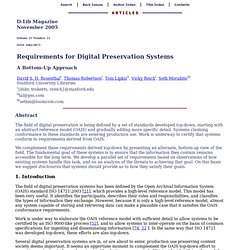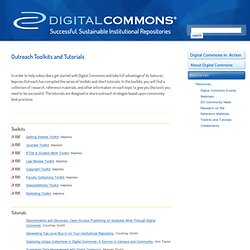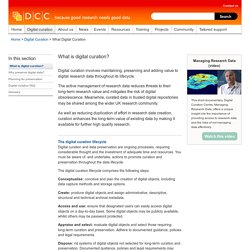

Open Data versus Privacy – AURA Network. Requirements for Digital Preservation Systems: A Bottom-Up Approach. Abstract The field of digital preservation is being defined by a set of standards developed top-down, starting with an abstract reference model (OAIS) and gradually adding more specific detail.

Systems claiming conformance to these standards are entering production use. Work is underway to certify that systems conform to requirements derived from OAIS. We complement these requirements derived top-down by presenting an alternate, bottom-up view of the field. The fundamental goal of these systems is to ensure that the information they contain remains accessible for the long term. 1. The field of digital preservation systems has been defined by the Open Archival Information System (OAIS) standard ISO 14721:2003 [21], which provides a high-level reference model.
Several digital preservation systems are in, or are about to enter, production use preserving content society deems important. 2 Goal No media, hardware or software exists in whose longevity designers can place such confidence. Digital Libraries class. PRIMO; Peer-Reviewed Instructional Materials Online. Metadata in repositories: An overview - Table of Contents. Toolkits and Tutorials. In order to help subscribers get started with Digital Commons and take full advantage of its features, bepress Outreach has compiled this series of toolkits and short tutorials.

In the toolkits, you will find a collection of research, reference materials, and other information on each topic to give you the tools you need to be successful. The tutorials are designed to share outreach strategies based upon community best practices. Follow index Toolkits Toolkits Getting Started Toolkit, bepress Journals Toolkit, bepress ETDs & Student Work Toolkit, bepress Law Review Toolkit, bepress Copyright Toolkit, bepress.
What is digital curation? The digital curation lifecycle Digital curation and data preservation are ongoing processes, requiring considerable thought and the investment of adequate time and resources.

You must be aware of, and undertake, actions to promote curation and preservation throughout the data lifecycle. The digital curation lifecycle comprises the following steps: Conceptualise: conceive and plan the creation of digital objects, including data capture methods and storage options. Create: produce digital objects and assign administrative, descriptive, structural and technical archival metadata. Access and use: ensure that designated users can easily access digital objects on a day-to-day basis. File Format Comparison Projects: Still Image and Audio-Visual Working Groups - Federal Agencies Digitization Guidelines Initiative. The FADGI Still Image and Audio-Visual Working Groups are exploring file formats for still images and video.

Two explorations are focused on reformatting, e.g., digitizing documents, books, maps, and photographs as still images, and digitizing videotapes (mostly analog, sometimes digital) as file-based video. These two comparisons employ similar, matrix-based tools to make comparisons relevant to preservation planning. The matrixes compare a limited number of formats in terms of roughly forty factors, grouped under the following general headings: Sustainability FactorsCost FactorsSystem Implementation Factors (Full Lifecycle)Settings and Capabilities (Quality and Functionality Factors) Raster Still Images for Digitization: A Comparison of File Formats Digital File Formats for Videotape Reformatting Meanwhile, a third exploration examines born digital video.
A Digital Preservation Conference. Home - COPTR - Confluence. Fifty Digital Preservation Activities You Can D... Search results. Open Source. Digital Libraries. World Digital Library Home. Creating Flexible E-Learning Through the Use of Learning Objects (EDUCAUSE Quarterly) Good Ideas Creating Flexible E-Learning Through the Use of Learning Objects The University System of Georgia deconstructs existing online courses to create separate files of reusable content By Marie Lasseter and Michael Rogers For five years, Advanced Learning Technologies (ALT), a unit within the Board of Regents of the University System of Georgia (USG), has worked with faculty and staff to develop the eCore, an electronically delivered core curriculum for the University System of Georgia.

The eCore contains courses leading to the completion of the first two years of an undergraduate degree. The ALT unit is also charged with assisting faculty and staff in using technology successfully, creating meaningful learning experiences, and expanding access to educational opportunities and resources. While faculty response to SCOUT was encouraging, feedback indicated that what they really needed was a quick way to find specific pieces of learning content so that courses could be custom designed. 10 Universities with Amazing Online Collections.